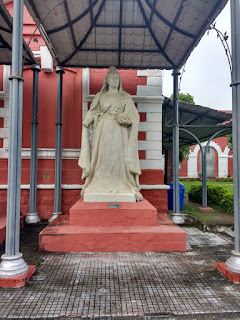 |
| statue of Queen Victoria, Nagpur, MH. indiasthan.com |
Nagpur city Maharashtra is the only city in the world having two statues of Queen Victoria in standing posture one mirror image of the other, but made at different years.
 |
| Nagpur, MH Central Museum (1863), India ffo.gov.in |
In the garden area of popular Central Museum (Locally known as the Ajab Bangla), Nagpur city there are two marble statues of Queen Victoria, one being the replica of the other. Both are damaged and the exterior appears to be not smooth and this could be due to prolonged exposure to vagaries of weather way back in the past. The statues, before Indian independence were installed by the British at Vidhan Bhavan and at Victoria Technical Institute (the place where Maharajbagh Zoo is located today).
Upon the death of Queen Victoria in 1901 in London, a Provincial Memorial Committee was formed under chairmanship of Chief Commissioner Sir Andrew Henderson Leith Fraser and a large section of people in the Central Provinces having connection with the Raj decided to have a statue erected in this city in her memory. Jabalpur city joined the band wagon and started fundraising separately to erect a statue there.A total of Rs.216000 was raised. A special Trust formed for this purpose, had allocated Rs.75000 for a Technical Institute to be named after queen Victoria to award bachelor's degree in sciences and the building came up on the Maharaj Bagh - garden.
The trust set aside Rs. 16,000 for the marble statue. The sculptor was Herbert Hampton of London West who also made a similar statue of Victoria on order from Jabalpur city. Both statues arrived in Bombay in 1906 by ship. The statue erected on a foundation in this garden in front the Victoria Institute in Nagpur was unveiled on 29th September 1906. At Jabalpur the statue was unveiled on 2nd March 1905.
 |
| Queen Victoria's statue, Lal Bagh palace,2020 Indore istockphoto.com |
Because of frustrations on the part of some misguided people, the Nagpur statue was desecrated in Nov. 1908 and subsequently the culprits were punished by the government. The tar patch on the defaced statue of Victoria was tough to be removed. So, a replica of the statue was made by the same sculptor Herbert Hampton on order and the money was collected through public subscription. This statue was shipped in 1912 and installed in Maharaj Bag in the same place.
The English statue busters after 1948, dislodged both tatues and put them in the Ambazari lake. Surprisingly after a long gap of 38 years in 1986, when the water level came down exposing the submerged statues, Department of Archeology and Museums took custody of them and later installed them at Nagpur’s Central Museum where they still stand today. The museum is under the Director of Department of Archaeology and Museums and Government of Maharashtra.
 |
| Two statues of Queen Victoria, Nagpur, India nationnext.com |
Above image: Queen Victoria's marble statues, Nagpur. Apparently the sculptor selected marbles from Carrara, Tuscany, Italy The statues are about 8 feet tall, showing Queen Victoria standing with her royal regalia, wearing Coronation robe, Garter Sash, with the Orb (made in 1661 for King Charles II) in left hand, the Scepter ( made in 1661 for King Charles II) in right hand and the Crown on head. Depicted as a middle aged lady the expression on her face is neither smiling nor stern; it is rather grave and confident but not haughty.
Sculptor Herbert Hampton, native of Hertfordshire, Kensington, was educated at art schools of Cardiff and Lambeth and then attended Westminster and Slade Schools, London; He had advanced training at Académies of Julian, Colarossi and Cormon academy, France. He was also very accomplished painter and sculptor..................................
https://www.academia.edu/36839870/THE_VICTORIA_STATUES_OF_NAGPUR_docx









